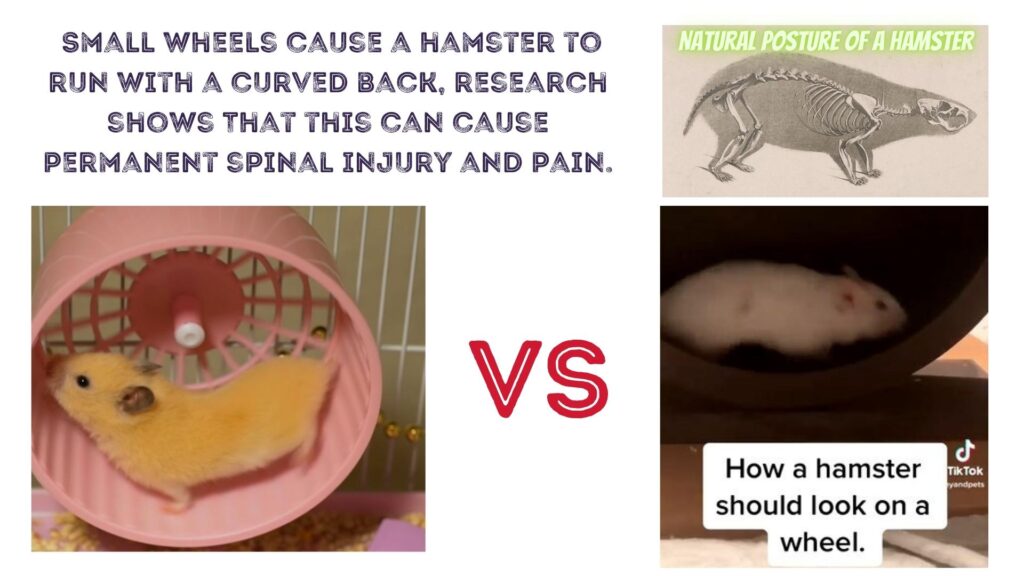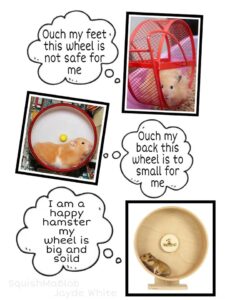 Often cages which are too small can’t fit an adequate sized hamster wheel. A small wheel can cause permanent injury to your hamsters back, leaving your hamster in unnecessary pain and discomfort.
Often cages which are too small can’t fit an adequate sized hamster wheel. A small wheel can cause permanent injury to your hamsters back, leaving your hamster in unnecessary pain and discomfort.
Hamsters are protected under The Animal Welfare Act and there is a good argument that small hamster wheels should be banned. In addition, Hamster cages which are too small to fit an adequate sized wheel should also be banned.
There is plenty of research that shows the injury that a small wheel will cause to your hamster. For example on the Wikipedia Hamster Wheel Page it says:
“Tierärztliche Vereinigung für Tierschutz (TVT) recommends wheels should be at least 20cm (8″) for Dwarf Hamsters and at least 30cm (12″) for Syrian Hamsters, since smaller diameters lead to permanent spinal curvatures, especially in young animals. “ The research also found that hamsters use their wheel for an average distance of 8.3km per night.
TVT Leaflet No. 62 – Pet keeping, accessories that do not protect animals
For Syrian’s 28cm (11″) wheels are readily available through online retailers such as Amazon and the community widely refer to these as being suitable.
Blue Cross Hamster Wheel Sizes
Blue Cross Warning Against Small Hamster Wheels
A suitable wheel is one that is large enough for your hamster to run in with a straight back and without having to raise their head, but small enough that they can rotate the wheel easily. It should be upright and have a solid running surface.”
Legislation
https://www.gov.uk/guidance/animal-welfare
It is a criminal offence to ignore the requirements of The Animal Welfare Act: – to provide a suitable environment and to protect your pet from pain, injury and suffering. When selling unsuitable products retailers are misleading you as a customer to break the law.
To provide a suitable environment and to protect hamsters from pain and suffering the following changes need to be made so that pet keepers are not breaking the law:
Changes to Cages to Accommodate a Suitable Wheel:
- Cages which are too small to accommodate at least a 6.5″ wheel should be banned. This wheel size is only suitable for a Roborovski hamster (the smallest type). A cage that is too small to fit a 6.5″ wheel can not provide a suitable environment for any species of hamster.
- A cage that is too small to fit a 28cm (11″) wheel should not be advertised as being a suitable cage for a Syrian Hamster.
Changes to Wheels so that they do not cause pain and suffering:
- Wheels with Metal Bars/Mesh Wire should be banned they cause Bumblefoot, sores and wounds.
- All Wheels below 6.5″ should be banned, this size is only suitable for a Roborovski hamster, anything smaller is not suitable for any size of hamster.
- Wheels which are smaller than 28cm (11″) should not be advertised as being suitable for a Syrian Hamster.

When looking at the natural posture of a hamsters skeleton it is clear to see that the back should not have an inverted arch and the head should not be tilted upwards for a prolonged period of time as happens when exercising on a small wheel
Pet Shops Label Tiny Wheels as Being Suitable for Both Syrians and Dwarf
 The Hamster loving community get frustrated to see tiny wheels being advertised as suitable for both Dwarf and Syrian Hamsters (This is probably because it would only fit a tiny cheap cage).
The Hamster loving community get frustrated to see tiny wheels being advertised as suitable for both Dwarf and Syrian Hamsters (This is probably because it would only fit a tiny cheap cage).
This 12cm wheel isn’t suitable for any hamster, scientific research shows that this will cause curvature of a hamsters back. This is an obvious example of an unsuitable product being marketed as suitable, when looking at a Syrian hamster use this wheel the back curvature issue is obvious to see.
A hamster would use this wheel for an average 8km a night and in the wild their back would remain straight, sadly for a hamster who uses this wheel it has to experience running with a curved back.
This silent spinner wheel is distributed by Sharples Pet they also specialise in tiny cages, edible chews and kapok bedding.
The Correct Size Wheel Doesn’t Fit in a Small Cage
Wheels With Metal Bars causes injury to almost all Hamsters in the Experiment
 78 out of 80 Hamsters who ran on a metal bar wheel showed wounds. “Each hamster paw was observed at 1–3-day intervals for 60 days. A total of 1–3 wounds, separate in time, developed on the paws (mostly the hind ones) of almost all animals. Wounds appeared as small pinpricks, cuts or scabs, mostly on the palms.”
78 out of 80 Hamsters who ran on a metal bar wheel showed wounds. “Each hamster paw was observed at 1–3-day intervals for 60 days. A total of 1–3 wounds, separate in time, developed on the paws (mostly the hind ones) of almost all animals. Wounds appeared as small pinpricks, cuts or scabs, mostly on the palms.”

Wheels we Recommend

Niteangel Hamster Wheel

Exotic Nutrition Hamster Wheel

Tic Tac Hamster Wheel

Hopes Healthy Treats 30cm Silent Wheel Cork Lined

Adjustable Height to Allow for Bedding Depth






